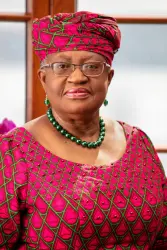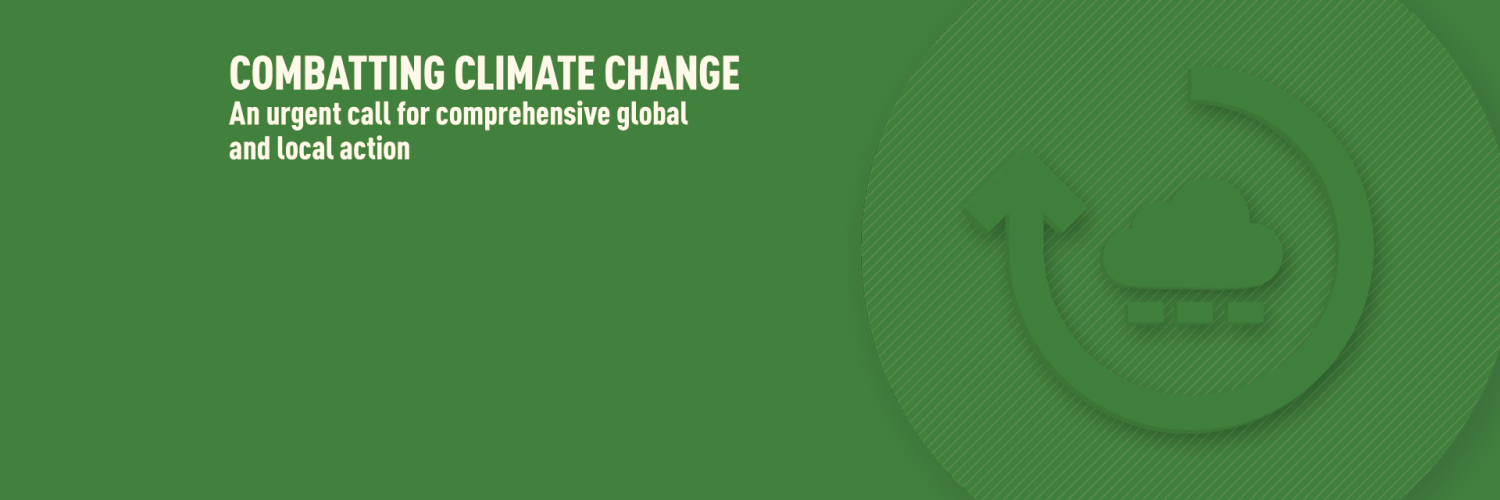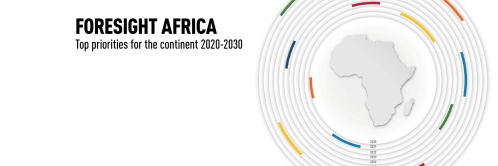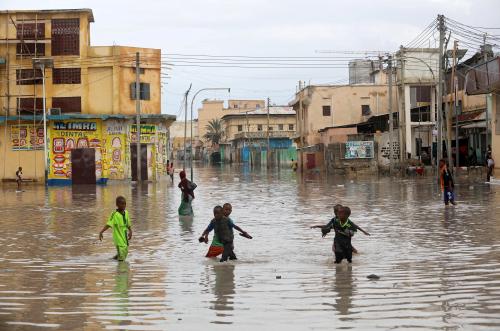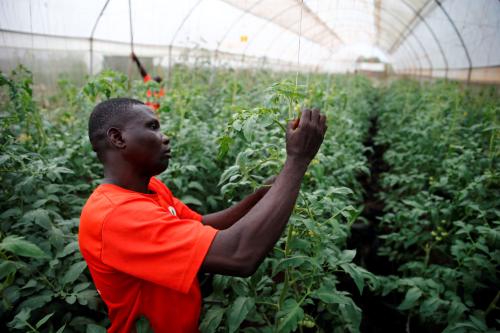Below is Chapter 4 of the Foresight Africa 2020 report, which explores six overarching themes that provide opportunities for Africa to overcome its obstacles and spur inclusive growth. Download the paper to see the contributing viewpoints from high-level policymakers and other Africa experts.

At the end of this year, world leaders are expected to come forward with updated, more ambitious national climate plans under the Paris Agreement. Though buried deep within the legalese of the Paris Agreement, this point of process is both a critical test and a once-in-a-lifetime opportunity.
Research from the New Climate Economy shows that bold climate action could deliver at least $26 trillion in global economic benefits between now and 2030. It could also generate over 65 million new low-carbon jobs by 2030, a number equivalent to the combined workforces of the United Kingdom and Egypt today; avoid over 700,000 premature deaths from air pollution compared with business-as-usual; and generate an estimated $2.8 trillion in government revenues in 2030 through subsidy reform and carbon pricing alone.1
Delivering the benefits of a new climate economy requires ambitious action across key economic systems, creating the conditions for the phaseout of coal and rapid scale-up of renewables in the energy sector; investing in shared, electric, and low-carbon transport in cities; scaling up sustainable food and land use systems, including forest landscape restoration; targeting investment to resilient water infrastructure; and reducing emissions from key industrial value chains, such as plastic.
However, if the world fails to step up climate action, continuing on our current climate trajectory could force 100 million people into extreme poverty by 2030.2 Africa is the most-exposed region to the adverse effects of climate change despite contributing the least to global warming.
The region is already disproportionately feeling the impacts related to a changing climate. Devastating cyclones affected 3 million people in Mozambique, Malawi, and Zimbabwe in the spring of 2018.3 GDP exposure in African nations vulnerable to extreme climate patterns is projected to grow from $895 billion in 2018 to about $1.4 trillion in 2023—nearly half of the continent’s GDP.4
If fairness was the only goal, the impetus to act would lie solely with developed economies. Make no mistake, the big emitters absolutely must step up their domestic climate action, and quickly. But building the new climate economy is also a once-in-a-lifetime opportunity that every African nation should prioritize and claim a stake in.
This opportunity is why, despite historically negligible carbon emissions, despite only accounting for 2 percent of world coal demand, and despite the lack of leadership from some developed countries, many African countries are now making serious efforts to transition towards low-carbon technologies, low-carbon and resilient infrastructure, and low-carbon tax systems.
Morocco has built the world’s largest concentrated solar facility to help achieve the country’s goal of 52 percent renewable energy mix by 2030. The advanced 6,000-acre solar complex, Noor, serves as a clean energy source for around 2 million Moroccans, and provides pivotal job opportunities as the country transitions away from the fossil fuel industry.5 The solar complex is also offering training programs for women for entrepreneurial and agricultural activities and is recruiting women in decision-making roles to guide project activities.6
South Africa’s Carbon Tax Act, which places specific levies on greenhouse gases from fuel combustion and industrial processes and emissions, came into effect in June 2019.7 By 2035, the carbon tax could reduce the country’s emissions by 33 percent relative to the baseline.8 Furthermore, South Africa’s recent renewable energy auctions have led to solar and wind prices lower than those of the national utility or from new coal plants.9 Often regarded as the continent’s clean energy trailblazer, much of what has been learned through South Africa’s renewable energy procurement process can influence similar developments across Africa.
My own country, Nigeria, which struggles with electricity access for a majority of its population, has set a renewable energy target of 30 percent by 2030.10 This goal underscores the potential for both grid-based and decentralized renewable energy investments to deliver energy access and climate change benefits simultaneously. Notably, off-grid solutions—like M-Kopa and Lumos that deliver electricity to thousands of households on the continent—and mini-grids are important options in both unserved rural areas and underserved urban areas. Natural resource-rich African countries, like Nigeria, should see renewables as a central part of achieving universal energy access while setting themselves on a pathway for low-carbon and resilient development.
The biggest energy companies see this future too and are working to diversify their global portfolios. As of September 2019, the world’s major oil companies had made about 70 clean-energy deals, putting them on track to surpass the total for 2018.11 Shell, for instance, has invested in SolarNow, which sells high-quality solar solutions in Uganda and Kenya. Since its inception in 2011, SolarNow has supplanted 210,000 tons of greenhouse gas emissions.12 More African countries should insist upon being recipients of this 21st century investment.
While the private sector is driving the shift into renewables, state-owned enterprises (SOE) in the energy sector—in Africa and globally—are lagging behind.13 African governments need to support reform in the SOE sector by, for example, introducing competitive procurement for electricity supply. This strategy could open African institutions and markets to emerging opportunities in the renewable sector, and even drive down the price of renewables.14 Efforts such as South Africa’s Renewable Energy Independent Power Producer Procurement (REIPPP) program and the World Bank and International Finance Corporation’s Scaling Solar program have resulted in solar prices as low as $0.05/kilowatt-hour.
Whether driven by opportunism or a sense of moral justice, the world’s developed and emerging economies must take action at home and help Africa deliver the investments that will bring the goals of the Paris Agreement within reach.
With an abundance of solar, wind, and geothermal resources, African countries already have a comparative advantage in renewables. The falling costs of green technologies provide a propitious moment to be on the delivery end of the new energy revolution. And while it may seem counterintuitive, Africa’s most oil- and gas-rich countries should be leading the energy revolution. Beyond the energy sector, food and land use systems—including the agriculture and forestry sectors—are integral to sub-Saharan Africa’s economy, accounting for 70 percent of livelihoods and almost one-quarter of regional GDP. In fact, new business opportunities in sustainable food and land use systems could deliver $320 billion each year by 2030 across sub-Saharan Africa.15 These opportunities include $120 billion in forest ecosystem services and restoration of degraded land, $100 billion in increased agricultural yields, and $100 billion in supply chain efficiency improvements and enhanced value-adding capacity. Concerted landscape restoration efforts in Ethiopia’s Tigray region, for example, are enhancing farmers’ resilience, water availability, and livelihoods.16 Such sustainable food and land use approaches can deliver multiple co-benefits, from reducing rural poverty, to boosting food security and improving population health, to protecting and regenerating natural capital.
Africa’s transition to a new climate economy is underway in many places. The question is: Will developed countries create a tail-wind or a head-wind? How they answer this question will determine whether Africa is positioned to fully capitalize on this opportunity. While it may not be polite to say so, African countries need money—both to build a cleaner more prosperous future for themselves and to avoid the worst impacts of climate change created largely by others.
The pending replenishment of the Green Climate Fund (GCF) acts as both a mechanism and a barometer for this challenge. The good news is that in October 2019, 27 countries confirmed their pledge to the GCF’s replenishment, bringing the total raised so far to $9.7 billion.17 The GCF is critical for maintaining momentum behind the Paris Agreement by supporting developing countries to enhance their climate action. But, so far, some major contributors have been silent. We need to hear from them.
African leaders cannot do this alone. And nor should they. Whether driven by opportunism or a sense of moral justice, the world’s developed and emerging economies must take action at home and help Africa deliver the investments that will bring the goals of the Paris Agreement within reach.
-
Footnotes
- Global Commission on the Economy and Climate, Unlocking the Inclusive Growth Story of the 21st Century: Accelerating Climate Action in Urgent Times (Washington D.C.: New Climate Economy, 2018).
- Stephen Hallegatte et al., Shock Waves: Managing the Impacts of Climate Change on Poverty (Washington D.C.: World Bank, 2016).
- Mark Yarnell and Devon Cone, Devastation and Displacement: Unprecedented Cyclones in Mozambique and Zimbabwe a Sign of What’s to Come? (Washington D.C.: Refugees International, 2019).
- Abdi Latif Dahir, “Africa’s fastest-growing cities are the most vulnerable to climate change globally,” World Economic Forum, December 21, 2018.
- Climate Investment Funds, “Solar plant the size of San Francisco powers Morocco’s sunlit ambitions,” Climate Home News, January 22, 2019.
- African Development Bank, Ouarzazate Solar Complex Project – Phase II (NOORo II and NOORo III Power Plants) (Abidjan: African Development Bank, 2014).
- Republic of South Africa, Act No. 15 of 2019: Carbon Tax Act, 2019 (Cape Town: Government of South Africa, 2019).
- Sifiso M. Ntombela, Heinrich R. Bohlmann, and Mmatlou W. Kalaba, “Greening the South Africa’s Economy Could Benefit the Food Sector: Evidence from a Carbon Tax Policy Assessment,” Environmental and Resource Economics 74, no. 2 (2019): 891-910.
- “Advancing Africa with Renewable Energy Auctions,” International Renewable Energy Agency, May 16, 2018.
- Jan Corfee-Morlot et al., Achieving Clean Energy Access in Sub-Saharan Africa (Paris: OECD/Financing Climate Futures, 2019).
- Timothy Abington and Kelly Gilblom, “Shell Leads Big Oil in the Race to Invest in Clean Energy,” Bloomberg, September 4, 2019.
- See https://www.solarnow.eu.
- Andrew Prag, Dirk Rottgers, and Ivo Scherrer, “State-Owned Enterprises and the Low-Carbon Transition,” OECD Environment Working Papers 129 (2018).
- Andrew Herscowitz, “The Unintended Consequences of Falling Solar Prices in Africa,” Medium, May 23, 2018.
- Food and Land Use Coalition, People, Health and Nature: A Sub-Saharan African Transformation Agenda (London: Food and Land Use Coalition, 2019).
- Cathy Watson, “Landscape restoration in Ethiopia brings watershed to life,” Agroforestry World, June 6, 2017.
- “Countries step up ambition: Landmark boost to coffers of the world’s largest climate fund,” Green Climate Fund, October 25, 2019.
The Brookings Institution is committed to quality, independence, and impact.
We are supported by a diverse array of funders. In line with our values and policies, each Brookings publication represents the sole views of its author(s).
